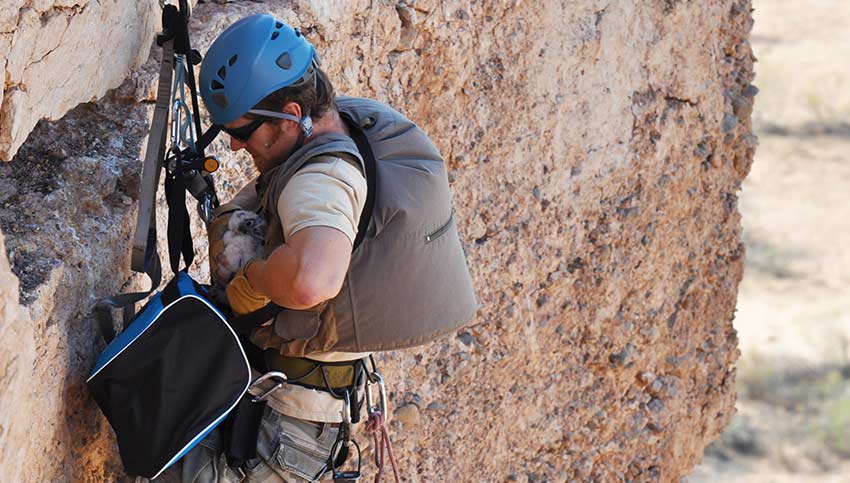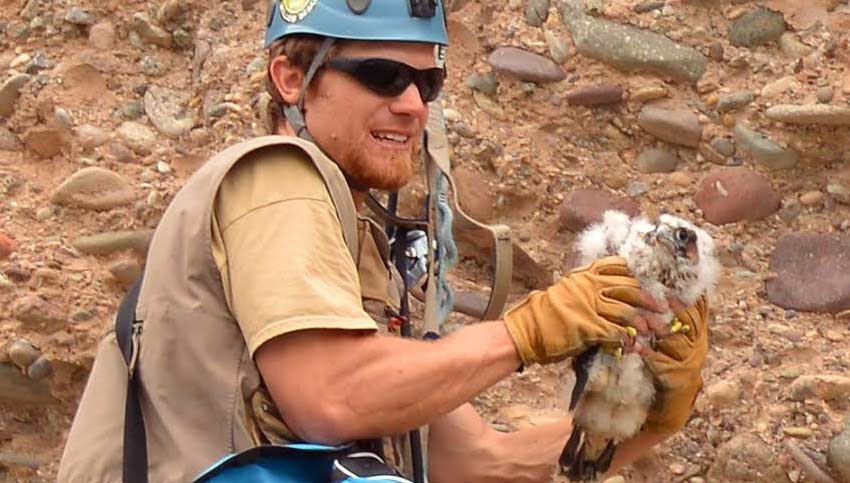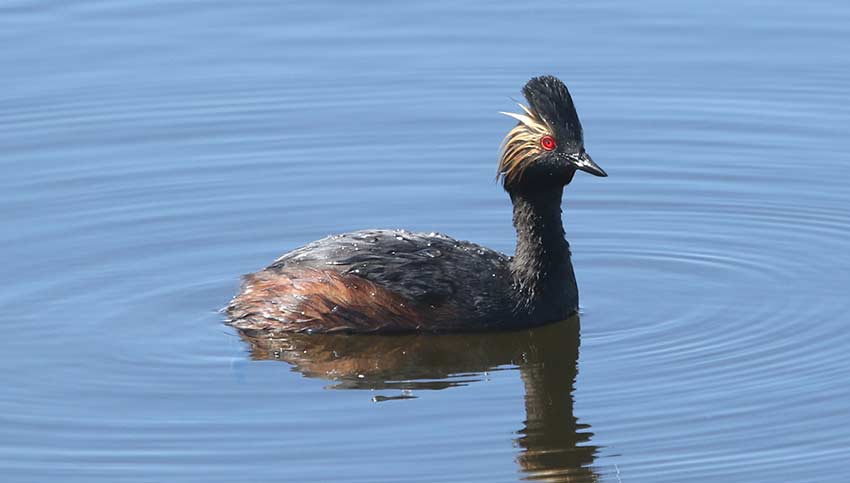
Joe Barnes, a wildlife biologist, scales the high cliffs to reach a peregrine falcon nestling. Studying big, powerful, sharp-taloned birds of prey like peregrine falcons takes a special kind of scientist. Not only are the birds challenging to work with, but this kind of research requires an eclectic combination of approaches that range from rappelling down vertical cliff faces to performing careful analyses in the laboratory. 
A peregrine falcon tail feather. Bird feathers function almost like extra kidneys, filtering out certain contaminants from the birds’ bodies. This makes sampling feathers an ideal way to study contaminants, like mercury1, in birds – not only is it an excellent indicator of how much methylmercury was circulating in the birds’ bloodstream while the feather was growing, but the procedure is minimally invasive and it can be performed repeatedly on individual birds over time. However, sampling peregrine falcon feathers does require capturing the birds, which isn’t an easy feat. To catch nestlings, researchers must rappel down cliff faces, delicately plucking the young birds from their nests while the birds’ parents are out hunting, and carefully carrying the nestlings back up the cliffs in a bag. Older peregrine falcons, which can fly away, require a different approach, so researchers capture them using harnessed pigeons as bait. Once a bird is in hand, the scientists clip off a tiny piece of one of its feathers. Back in the lab, they used spectrometry – a scientific process that uses light to determine the presence of certain compounds – to test the feather for mercury. Every bird the researchers have tested has had detectable levels of mercury in its feathers. Peregrine falcons living near Lake Mead and Lake Mohave have had levels that were far greater than peregrines elsewhere in Southern Nevada – about seven times higher, on average. These results suggest that these birds are eating something that’s high in mercury. 
This peregrine falcon nestling will be tested for signs of mercury by clipping off a tiny piece of one of its feathers. To figure out what that was, the researchers had to somehow get samples of the birds’ food. Luckily, peregrines tend to leave behind their prey’s feathers after a meal. So the scientists scavenged through peregrines’ nests for these telltale signs of their prey. They analyzed each feather to determine what type of bird it used to belong to and then tested these feathers for mercury contamination. Eared grebes were the biggest culprits – not only did these birds make up about fifteen percent of the peregrines’ diet, they also had the highest mean mercury concentration of the 94 prey species that the researchers analyzed. It’s likely that these birds are bringing in mercury from afar; eared grebes winter at Utah’s Great Salt Lake, an area known for its significant mercury contamination. 
Eared grebes make up about fifteen percent of the peregrines’ diet, they also contain the highest mean mercury concentration of the 94 prey species analyzed. Lake Mead’s ecosystem has relatively low mercury levels - a recent study found that just five percent of fish samples had unusually high mercury concentrations. However, the peregrine falcon study suggested that, besides the grebes, some of the peregrines’ prey that lives year-round at lakes Mead and Mohave feed on mercury-laden foods. So far, it’s unclear how that mercury has made its way into the ecosystem. Questions about tolerance and toxicity also remain unanswered; studies elsewhere have identified how much mercury is dangerous to some other species of birds, such as bald eagles, but that information is less clear for peregrine falcons. Although the levels of mercury that researchers found in the peregrines at lakes Mead and Mohave seem high, the researchers haven’t seen any obvious signs of nervous system problems in the birds. It’s possible that mercury levels are affecting how many birds survive and reproduce, but research needs to continue in order to identify these trends. |
Last updated: April 5, 2017
